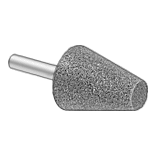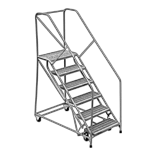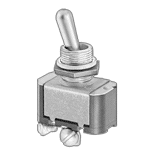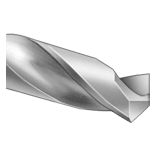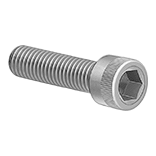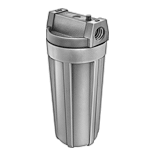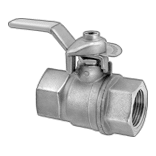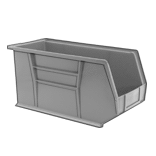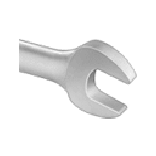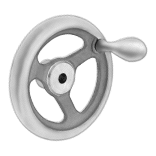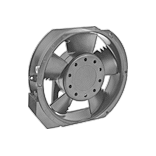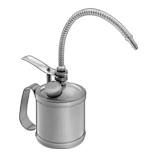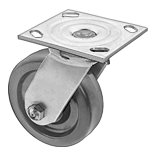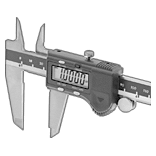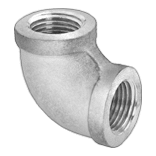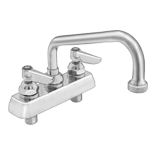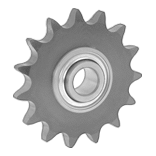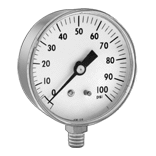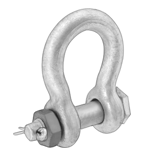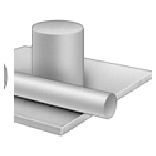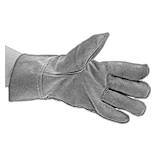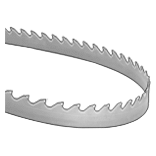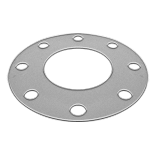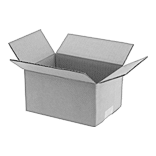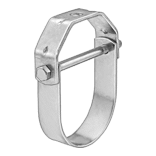Filter by
Reamer Diameter
Reamer Fractional Size
Shank Type
System of Measurement
Sold As
Reamer Type
Finish
DFARS Specialty Metals
Export Control Classification Number (ECCN)
Reamer Operation
Spiral Direction
Recommended Expansion Limit
Reamers
Finish holes to precise inch, metric, wire gauge, or letter sizes with these reamers.
Round Shank
Straight Flute |
Spiral Flute |
These reamers fit in the chuck of drill presses, turret lathes, and other machine and power tools, making them the most common shank type.
Straight Flute—The most common flute style, these reamers are suitable for a wide range of applications, but not recommended for holes with a keyway or other breaks in the surface.
Spiral Flute—Since these reamers clear chips better than straight flutes, they leave holes with a smoother finish. They're better for holes with breaks in the surface, such as a keyway, because they cut continuously across the breaks instead of moving in and out.
High-Speed Steel—Durable and wear resistant, these are good for general purpose reaming in most materials.
Carbide-Tipped Tool Steel—Since these reamers retain a sharper, harder edge at higher temperatures than high-speed steel and cobalt steel, they can be used on hard materials, such as iron, hardened steel, and steel alloys. They aren't as brittle as solid carbide reamers, so they can be used in less rigid setups, such as a hand-held drill.
Right-Hand Spiral—These reamers pull chips upward as they cut, so they're often used in blind holes.
Lg. | |||||||||||||||||||||||||||||||||||||||||||||||||||||||||||||||||||||||||||||||||||||||||||||||||||
|---|---|---|---|---|---|---|---|---|---|---|---|---|---|---|---|---|---|---|---|---|---|---|---|---|---|---|---|---|---|---|---|---|---|---|---|---|---|---|---|---|---|---|---|---|---|---|---|---|---|---|---|---|---|---|---|---|---|---|---|---|---|---|---|---|---|---|---|---|---|---|---|---|---|---|---|---|---|---|---|---|---|---|---|---|---|---|---|---|---|---|---|---|---|---|---|---|---|---|---|
Reamer Dia. | Material | Flute | Overall | No. of Flutes | Spiral Direction | Cutting Dia. Tolerance | For Use On | Each | |||||||||||||||||||||||||||||||||||||||||||||||||||||||||||||||||||||||||||||||||||||||||||
Straight Flute | |||||||||||||||||||||||||||||||||||||||||||||||||||||||||||||||||||||||||||||||||||||||||||||||||||
Inch | |||||||||||||||||||||||||||||||||||||||||||||||||||||||||||||||||||||||||||||||||||||||||||||||||||
| 0.5313" (17/32") | High-Speed Steel | 2" | 8" | 8 | — | 0" to 0.0003" | Aluminum, Brass, Bronze, Iron, Plastic, Stainless Steel, Steel | 2995A75 | 000000 | ||||||||||||||||||||||||||||||||||||||||||||||||||||||||||||||||||||||||||||||||||||||||||
| 0.5313" (17/32") | Carbide-Tipped Tool Steel | 2" | 8" | 6 | — | 0" to 0.0003" | Aluminum, Brass, Bronze, Fiberglass, Iron, Nickel, Plastic, Stainless Steel, Steel, Titanium, Tool Steel, Hardened Steel | 3025A37 | 00000 | ||||||||||||||||||||||||||||||||||||||||||||||||||||||||||||||||||||||||||||||||||||||||||
Spiral Flute | |||||||||||||||||||||||||||||||||||||||||||||||||||||||||||||||||||||||||||||||||||||||||||||||||||
Inch | |||||||||||||||||||||||||||||||||||||||||||||||||||||||||||||||||||||||||||||||||||||||||||||||||||
| 0.5313" (17/32") | High-Speed Steel | 2" | 8" | 6 | Right Hand | 0" to 0.0003" | Aluminum, Brass, Bronze, Iron, Plastic, Stainless Steel, Steel | 3106A43 | 00000 | ||||||||||||||||||||||||||||||||||||||||||||||||||||||||||||||||||||||||||||||||||||||||||
Expandable Flutes, Round Shank
Straight Flute |
Unlike standard reamers, which are unusable once they become worn, these can be returned to their original size for finishing holes. After the reamer is worn down, tighten the set screw to expand the diameter, grind the reamer to its original size, and get back to work.
These are not designed for producing holes larger than the listed diameter or for producing holes of various sizes. The set screw should not be loosened.
These reamers fit in the chuck of drill presses, turret lathes, and other machine and power tools, making them the most common shank type.
Straight Flute—The most common flute style, these reamers are suitable for a wide range of applications, but not recommended for holes with a keyway or other breaks in the surface.
Carbide-Tipped Tool Steel—Since these reamers retain a sharper, harder edge at higher temperatures than high-speed steel and cobalt steel, they can be used on hard materials, such as iron, hardened steel, and steel alloys. They aren't as brittle as solid carbide reamers, so they can be used in less rigid setups, such as a hand-held drill.
Lg. | |||||||||||||||||||||||||||||||||||||||||||||||||||||||||||||||||||||||||||||||||||||||||||||||||||
|---|---|---|---|---|---|---|---|---|---|---|---|---|---|---|---|---|---|---|---|---|---|---|---|---|---|---|---|---|---|---|---|---|---|---|---|---|---|---|---|---|---|---|---|---|---|---|---|---|---|---|---|---|---|---|---|---|---|---|---|---|---|---|---|---|---|---|---|---|---|---|---|---|---|---|---|---|---|---|---|---|---|---|---|---|---|---|---|---|---|---|---|---|---|---|---|---|---|---|---|
Reamer Dia. | Material | Flute | Overall | No. of Flutes | Cutting Dia. Tolerance | Recommended Expansion Limit | For Use On | Each | |||||||||||||||||||||||||||||||||||||||||||||||||||||||||||||||||||||||||||||||||||||||||||
Straight Flute | |||||||||||||||||||||||||||||||||||||||||||||||||||||||||||||||||||||||||||||||||||||||||||||||||||
Inch | |||||||||||||||||||||||||||||||||||||||||||||||||||||||||||||||||||||||||||||||||||||||||||||||||||
| 0.5313" (17/32") | Carbide-Tipped Tool Steel | 1" | 8" | 6 | 0" to 0.0003" | 0.010" | Aluminum, Brass, Bronze, Fiberglass, Iron, Nickel, Plastic, Stainless Steel, Steel, Titanium, Tool Steel, Hardened Steel | 3107A12 | 000000 | ||||||||||||||||||||||||||||||||||||||||||||||||||||||||||||||||||||||||||||||||||||||||||
